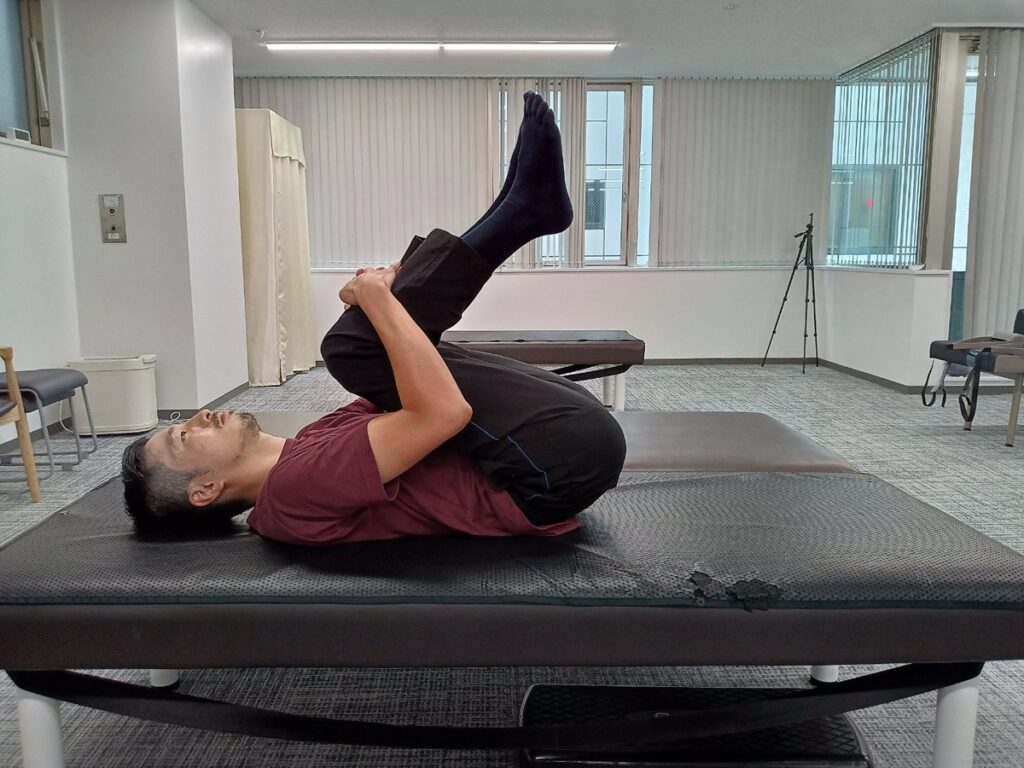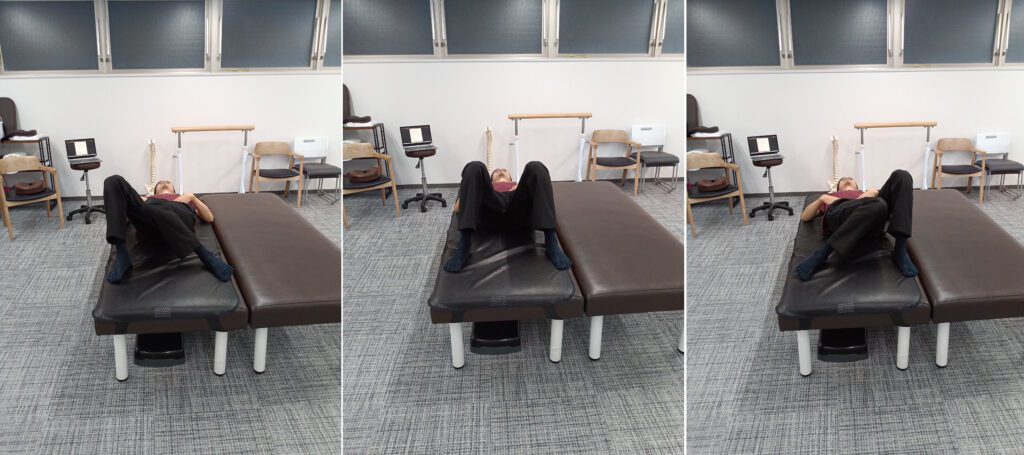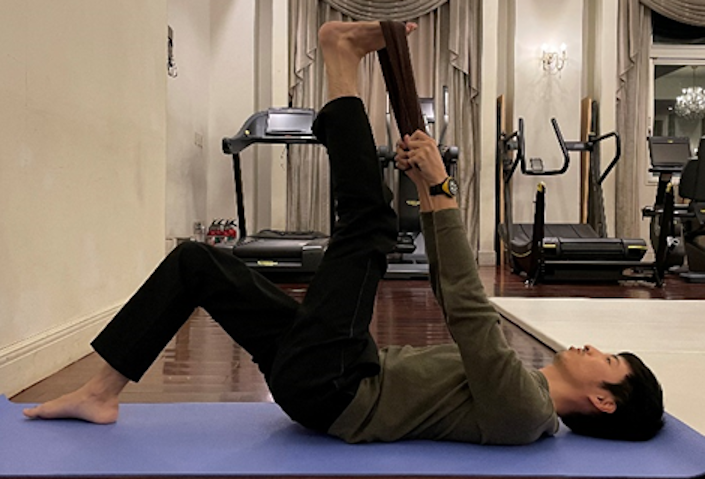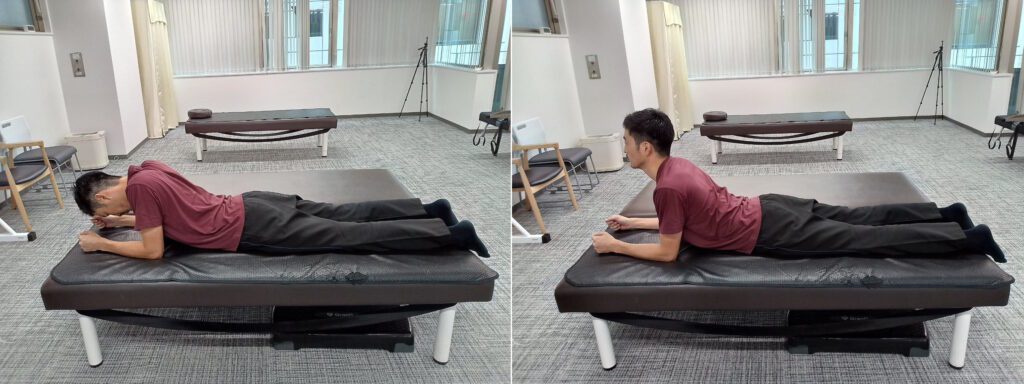September 29, 2023
When a lumbar disc herniation develops, symptoms such as buttock pain, leg pain and numbness in the lower back may suddenly affect your daily life. To prevent this from happening, there are several aspects that you should be aware of on a daily basis.
In this issue, we will discuss some recommended training routines.
Occurrence of disc herniation and how to prevent it
Herniated discs protrusions are almost always posterior or postero-lateral in nature.
In 2005, an experiment was conducted in Canada to investigate the direction in which herniated discs protrude. It was found that the nucleus pulposus always migrates in the direction opposite to the direction in which the disc gets bent. *1
*1 Reference article: Crystal D Aultman 1, Joan Scannell, Stuart M McGill. The direction of progressive herniation in porcine spine motion segments is influenced by the orientation of the bending axis. Clinical Biomechanics, 20(2005).
As described above, the direction of disc protrusion is related to the way the body is mobilized, so correcting one’s usual posture and body movements can prevent the worsening or recurrence of disc herniation to some extent.
Recommended training routines for disc herniation
Training to strengthen the lumbar area will help keep the lumbar vertebrae in a physiological forward leaning posture (avoiding excessive bending at the waist), and will also make the muscles around the waist and legs more flexible, which can be effective in preventing the worsening and recurrence of a herniated lumbar disc.
Stretch holding both knees
This stretch helps to avoid overbending the lower back and also helps to stretch the muscles that support the spine and the buttocks.
Lie on your back and hold both knees with both hands.
Exhale and hold the knees close to the chest for 10 seconds.
Try to keep your hips as far off the mat as possible when bringing your knees to your chest.

Lower Back Twist Stretch
This stretch improves movement around the hips and corrects the habit of bending over at the waist. It also improves the stretching of the muscles that support the spine and the muscles of the lower legs.
- Lie on your back and slightly spread your legs.
- Keeping your buttocks on the mat, roll your right leg to the left side.
- Hold the posture for 10 seconds while exhaling slowly.
- Tilt the left leg down as well and hold the position for 10 seconds.

Thigh Stretch
This stretch improves the movement of the lower back, corrects the habit of bending over at the waist, and stretches the muscles of the back of the thighs and calves.
- Lie on your back, both knees up and slightly spread your legs.
- Hold a hand towel with both hands and place it on the sole of your right foot.
- While still on your back, stretch the leg in the towel toward the ceiling.
- Hold the posture for 10 seconds while exhaling slowly.
- Repeat the process with the left leg.

Bending Both Knees Stretch
This stretch is effective for lengthening the lumbar spine as well as the muscles in front of the abdomen and thighs.
- Lie on your stomach and prop your upper body on both elbows.
- Bend both knees upward and hold the position for 10 seconds while exhaling slowly.
Keep your eyes towards the floor while doing this, as tilting your head back will cause your lower back to arch too far.

Stretching the back of the thighs
This stretch stretches the muscles of the back of the thighs and prevents too much strain on the lumbar spine.
- Squat down from a standing position and grasp both ankles with both hands.
- Extend both knees while keeping the chest and front of the thighs close together.
- Hold the posture for 10 seconds while exhaling slowly.
Be careful to keep your chest and thighs together. If extending the knees fully is too difficult, bend them slightly.

Precautions to take when performing this routine
All stretches should be performed provided that they do not cause any pain.
You can start by doing them once or twice and gradually increase the number of sessions.
Since continuity is an important part of training, make sure to perform those routines within a reasonable range.
Cases when you should avoid stretching
If you begin to experience pain or numbness after exercising, stop training right away and consult your doctor.
If you have been experiencing symptoms of a herniated disc, training may make your symptoms worse. If you have already been diagnosed with a herniated disc, it is safer to consult with your doctor ahead of time to see what exercises you can perform.
Treatment at our clinic
Although training has been found to be effective in preventing disc herniation, if you have already been diagnosed with a herniated disc, you will need to treat the disc damage that is causing the herniation.
Our clinic offers the Cellgel method, a treatment that repair damaged discs.
With our Cellgel method, a drug is injected to fill the cracks in the disc, and then turns into a gel that fill up the cracks, thus providing a fundamental treatment. It is characterized by the fact that the volume of the disc is not reduced, and the drug remains in the disc as a gel-like implant after treatment, thus preserving the disc.
ILC also offers “back pain-specific rehabilitation,” which can be used for various types of back pain and within a wide range of age groups.
ILC’s Specialized Back Pain Rehabilitation
If you are suffering from back pain or have been diagnosed with a herniated disc, please consider seeing us for a consultation.
Related Articles
What is a herniated lumbar disc? Causes of Pain and Symptoms
Various Treatments for Lumbar Disc Herniation: Respective Differences and Results of Each Method
Understanding Herniated Discs and Receiving the Most Appropriate Treatment For It
Is Disc Herniation for Teens and Young Adults on the rise?
Things You Can Do During Work From Home to Prevent Intervertebral Disc Herniation



